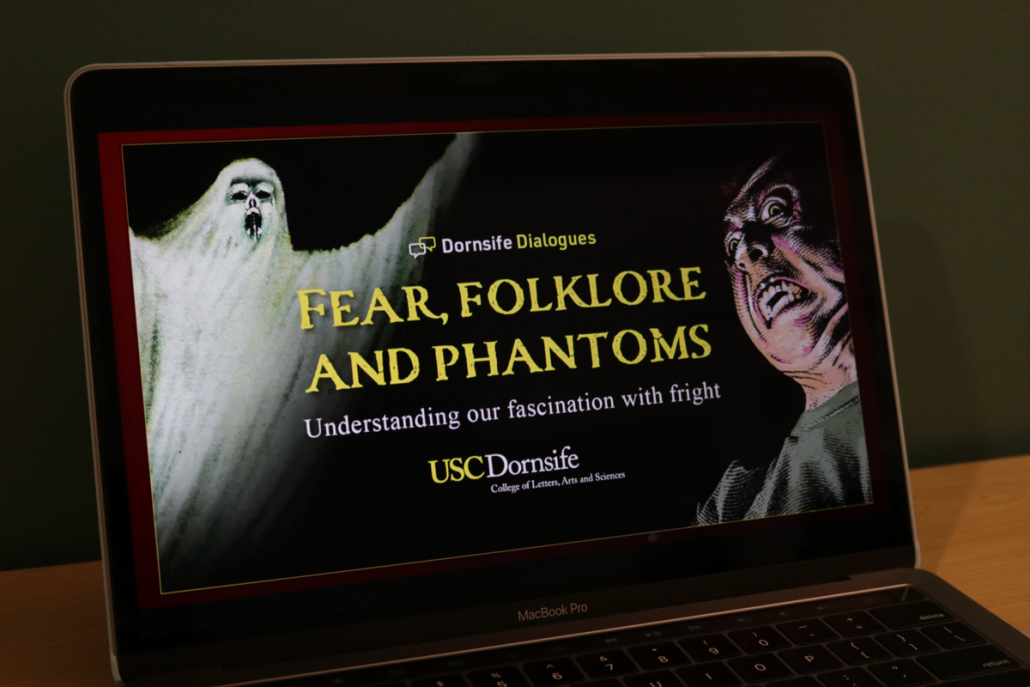The season of Fear, Folklore and Phantoms

As autumn sends Los Angeles its first gentle breeze of October, Halloween is right around the corner. To uncover the mysteries of society’s fascination with Halloween, the Dornsife College of Letters, Arts and Sciences held a Zoom panel Monday to discuss the appeal of the holiday, and the relationship between ghosts and humans.
The event, introduced by Dornsife Dean Amber Miller was moderated by Lisa Bitel, Dean’s professor of religion and history. Guest panelists included Tok Thompson, professor of anthropology, and Leo Braudy, professor of English, art history and history and the Leo S. Bing Chair in English and American literature.
Bitel opened the event by explaining the festival of Samhain in the Celtic culture. Samhain takes place on Nov. 1, with Oct. 31 being Samhain’s eve. In Irish mythology, Samhain’s eve is the time when ghosts and demons tread on earth, characteristics that influence modern Halloween.
“Samhain, the day that for thousands of years has been celebrated as the beginning of winter and the beginning of [a] time [of] darkness and a time when the crevices between our world and another world open,” Bitel said. “Not always to allow the dead and living to mix, but sometimes to allow all kinds of beings to mix with others.”
The frightfulness of Halloween is not only evident in its origins but also by people’s fear of the supernatural, Braudy said. The desire to understand life and death is often what brings ghosts to people’s attention. Analyzing this phenomenon, Braudy said religion plays a significant part by attempting to address the boundaries between life and death and the uncertainties of that relationship.
This gives people a sense of “what it is like to be alive or somehow have relationships with those who are dead,” Braudy said.
Thompson added that people’s perceptions of ghosts also vary across cultures. In some cultures, people do not believe in ghosts at all, while in other cultures, people describe ghosts in many different ways.
“The way that the afterlife is thought of, or souls are thought of, or the cosmos and our relation to it is thought of is wonderfully, wonderfully diverse,” Thompson said.
Thompson described how when considering ghosts, people often connect them with those who have been mistreated. He continued to explain that there is always immorality related to the presence of haunting ghosts, which implies people can get haunted by ethical failures. However, ghosts are only one part of the moral issues related to Halloween. Braudy said other stories of supernatural beings, both on earth and extraterrestrial, are associated with morals.
“They are all very much about our fears and our hopes, and the clash between the two of them,” Braudy said.
In many generational horrors, there have been some common themes, such as history and social ills, that lead to the discussion of morals. Thompson talked about how American ghost stories that take place on Native American burial grounds reflect and tell a societal history of those who have been wronged.
For Braudy, the themes may also reveal what is repressed in society. The horror element of these stories serves as the psychotherapy that forces American culture to face its own ills. Just as the problems in many ghost stories can be eventually resolved, the panelists agreed that the way to solve what haunts society is to right the wrongs.
The modern depiction of ghosts, supernatural creatures and their stories is not solely in books and conversations. Panelists described their presency through various types of new technologies, such as AIs, films and stop-motion photography. According to the panelists, the new technologies can help people see things that appear to be “supernatural” and even reconnect with their deceased loved ones. Technology does not develop new types of horror: It only reflects the ones that already exist.
“You can’t just make stuff up,” Thompson said. “You can’t have ghosts act in a completely different way or people won’t buy it. That’s not right. That’s not how they act. There [are] limits to the tradition. There’s agency within the limits but limits within the tradition.”
The guest speakers also discussed the future for ghosts and monsters and what people may feel haunted by in the coming years. Braudy indicated that, contrary to the past, the most preoccupied creatures at the moment are zombies. This is because people shifted from fearing single monsters to fearing groups of monsters. This reflects people’s potential fear of the masses in the future. Thompson added that xenophobia and racism also instigated this fear.
“This sort of the idea of xenophobia, [is] that there are always the other and they’re not really people, so it’s okay to kill them because they’re not really people. All they want to do is take us over, [and] take our brains over,” Thompson said.
Near the end of the panel, the professors recommended books for audience members interested in learning more about horror and supernaturals. Thompson introduced “Ghosts and the Japanese” by Michiko Iwasaka and Barre Toelken and “Shakespeare in the Bush” by Laura Bohannan. Braudy presented his book “Haunted: On Ghosts, Witches, Vampires, Zombies, and Other Monsters of the Natural and Supernatural Worlds.”
“The basic argument [in the book] is: Which religion has a better relationship to the spirit world?” Braudy said. “Which religion knows what god is really doing? So that conflict yields all sorts of the ghosts and gives it a quantum push forward.”

